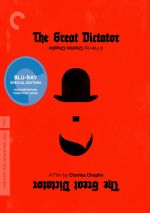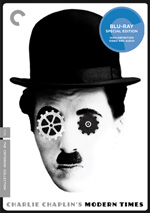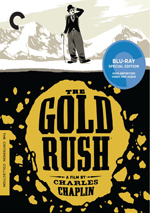|
CRITERION
|

| |
|
MOVIE INFO
|
|
Director:
Charles Chaplin
Cast:
Charlie Chaplin, Jack Oakie, Reginald Gardiner, Henry Daniell, Billy Gilbert, Grace Hayle
Writing Credits:
Charles Chaplin
Tagline:
Once again - the whole world laughs!
Synopsis:
In his controversial masterpiece The Great Dictator, Charlie Chaplin offers both a cutting caricature of Adolf Hitler and a sly tweaking of his own comic persona. Chaplin, in his first pure talkie, brings his sublime physicality to two roles: the cruel yet clownish “Tomainian” dictator and the kindly Jewish barber who is mistaken for him. Featuring Jack Oakie and Paulette Goddard in stellar supporting turns, The Great Dictator, boldly going after the fascist leader before the U.S.’s official entry into World War II, is an audacious amalgam of politics and slapstick that culminates in Chaplin’s famously impassioned speech.
Box Office:
Budget
$2 million.
MPAA:
Rated NR
| |
|
DISC DETAILS
|
Presentation:
Aspect Ratio: 1.33:1
Audio:
English LPCM Monaural
Subtitles:
English
Closed-captioned
Supplements Subtitles:
None
Runtime: 125 min.
Price: $39.95
Release Date: 5/24/2010
Bonus:
• Audio Commentary with Performer/Author Dan Kamin and Silent Film Historian Hooman Mehran
• Re-release Trailer
• “The Tramp and the Dictator” Documentary
• Two Visual Essays
• Color Production Footage
• Sequence from 1921’s King, Queen, Joker
• Deleted Sequence from 1919’s Sunnyside
• Booklet
| |
|
PURCHASE @ AMAZON.COM
|

| |
|
EQUIPMENT
|
Panasonic TC-P60VT60 60-Inch 1080p 600Hz 3D Smart Plasma HDTV; Sony STR-DG1200 7.1 Channel Receiver; Panasonic DMP-BD60K Blu-Ray Player using HDMI outputs; Michael Green Revolution Cinema 6i Speakers (all five); Kenwood 1050SW 150-watt Subwoofer.
| |
|
RELATED REVIEWS
|


| |
|
The Great Dictator: Criterion Collection (1940)
|
|
Reviewed by Colin Jacobson (February 23, 2016)
While not Charlie Chaplin’s most famous – or most beloved – film, 1940’s The Great Dictator likely stands as his most controversial. The movie opens in 1918 toward the end of World War I. After a few battles, a Jewish soldier (Chaplin) from the land of Tomainia – who works as a barber during peacetime – gets a head injury. This lands him in the hospital for years, as his memory loss keeps him institutionalized.
And keeps him unaware of world events and the current situation in Tomainia. In response to the Great Depression and various woes, a bigoted despot named Adenoid Hynkel (also Chaplin) comes to power and rules the land with an iron fist. In particular, Hynkel takes out his rage on the Jews, who he regards as sub-human.
Thus the Jews of Tomainia suffer from severe discrimination. Unaware that he’s been gone for years, the Barber returns to his shop and finds himself stuck in the middle of all the bigotry for reasons he can’t comprehend since he doesn’t have the slightest clue about his country’s political climate. We follow the Barber’s adventures as well as the actions of Hynkel as they go along parallel paths.
I suppose any critique of Dictator needs to look at two issues. First, the film’s historical relevance should be considered. In that realm, Dictator deserves to be commended. In an era when US-produced movies shied away from the wars in Europe – largely due to a strong American isolationist movement at the time – Chaplin took a stand and used popular entertainment to cast a light on the issues. That took guts, and Chaplin should be commended for his actions.
As for the movie itself… well, I’m more equivocal about it. In reality, Dictator acts as two films combined into one. For the most part, the stories of the Barber and Hynkel don’t intersect; they tie in at the end, but otherwise, they unfold fairly independently.
That trend really does make Dictator disjointed, as Chaplin doesn’t manage to meld the two particularly well. No, the flick never presents jarring transitions, but it doesn’t flow in a smooth manner either. Instead, we simply go from one character to the other without clear rhyme or reason.
In truth, I think Dictator would’ve worked better if it stayed on one character or the other. Yes, the (in)famous ending needs both roles, but that’s a separate matter I’ll eventually discuss. For most of the movie’s running time, it feels disjointed, and I think that a flick about Hynkel or the Barber would’ve fared better.
The running time is part of the issue. Dictator was by far Chaplin’s longest film to that point; in comparison, it was about 50 percent longer than 1936’s 87-minute Modern Times. I just don’t think Chaplin really has two hours of story to tell here, as even with the dual characters/plots, the movie tends to drag. I think Chaplin worked best within shorter spans and he can’t fill the 125 minutes with enough to keep us occupied.
My main issue remains the dual stories, as they’re not created equally. A version of Dictator that focused solely on Hynkel would’ve been superior, I think. For one, Chaplin delivers a much stronger performance as the title character. When he plays the Barber, he seems tired. The Barber is essentially just another version of the Little Tramp, and Chaplin feels a bit bored with the role.
The decision to allow the Barber/the Tramp to speak doesn’t help; it’s simply jarring to finally hear that character talk, and his lines don’t benefit the film. While it might’ve seemed weird to have a mute personality among all the other talking roles, I think it would’ve been more consistent and satisfying.
Even if he remained silent, I still suspect Chaplin would appear tired in the role, while he demonstrates great gusto as Hynkel. It’s really a day and night difference; when he plays Hynkel, Chaplin becomes a man unleashed and a force of nature. He manages to make Hynkel look both like a fool and a threat, which is no mean feat. It’d be easy to create a totally cartoon villain, but that wouldn’t work because Chaplin wants us to understand Hitler’s real threat. In his hands, he makes Hynkel fearsome, loathsome and moronic; it’s a terrific performance.
Indeed, Chaplin’s strengths as Hynkel just reconfirm his weaknesses as the Barber – and make me think he should’ve created two separate films to tell his story. Dictator doesn’t need to contrast Hynkel and the Barber, and Chaplin’s lack of energy in the latter part robs the story of momentum.
It also doesn’t help that Chaplin relegates virtually all of the movie’s moralizing and messages to the Barber scenes. Some of these come through the consistently annoying Hannah (Paulette Goddard). She chirps and giggles her way through the role in a manner that seems awfully incongruous, and the movie saddles her with some of its more obvious “message moments”, such as the not-so-subtle segment when she tells us – and isolationist America - “we can lick ‘em all together!”
For the movie’s most blatant message – and its most controversial segment – we turn to the Barber. At the end of the film, Chaplin essentially breaks character to deliver a long speech about rising above, fighting back and all that stuff.
I have no problems with filmmakers who insert messages in their movies, but a little subtlety goes a long way. Bringing a story to a halt so a character can rant for a few minutes – even when done eloquently – just isn’t good filmmaking. I think Chaplin gets a pass because of who he was; very other directors could’ve provided such blatant preaching and have it viewed in a positive way.
I simply don’t think it works, though, and that sentiment goes for much of the Barber part of the movie. When Dictator focuses on the title character, it does quite well for itself, but the rest of the movie fares less well. This ends up as a truly up and down film that intersperses brilliance with borderline propaganda.
|
The Disc Grades: Picture B+/ Audio B-/ Bonus B
|
|
The Great Dictator appears in an aspect ratio of 1.33:1 on this Blu-ray Disc. The movie held up well after all the decades.
Sharpness tended to be strong. A smidgen of softness occasionally occurred, but not to a notable degree. Most of the movie looked accurate and well-defined. No issues with jaggies or shimmering occurred, and I noticed no edge haloes.
Source flaws weren’t a big factor. The movie sometimes took on a flickery quality, and a few marks appeared, but nothing major marred the presentation. Blacks were fairly deep and tight, while shadows showed pretty good clarity. This ended up as a positive presentation.
I thought the film’s LPCM monaural audio held up fine for its age. Speech betrayed some thinness but always remained intelligible and usually seemed fairly distinctive. Music was acceptably clear and concise, while effects demonstrated decent accuracy; those elements lacked much punch, but they avoided most distortion. For a more than 75-year-old soundtrack, Dictator seemed pretty good.
How did the Blu-ray compare to Criterion’s DVD release? Audio might’ve had a smidgen more range, but given the age of the material, there wasn’t much the lossless track could do to improve the mix. Visuals showed a step up, though, as the Blu-ray was more precise and smoother. I liked the DVD but the Blu-ray fared better.
The Blu-ray offers the same extras as the Criterion DVD. We get a re-release trailer as well as an audio commentary from performer/author Dan Kamin and silent film historian Hooman Mehran. Both sit for separate, running, screen-specific tracks that get edited together for this “tag-team” chat. They discuss story, characters and themes, music and audio, cinematic techniques, cast and performances, historical context, the film's reception and a few connected topics.
The commentary’s format gets a little muddled at times, as it handles transitions between Mehran and Kamin in a semi-goofy manner. Nonetheless, the commentators deliver a fine array of notes related to the movie and demonstrate a good understanding of the subject matter. They even show disagreements, as it appears Kamin likes the film more than Mehran does. Expect to learn a lot about Dictator via this interesting piece.
Next we go to a 2001 documentary called The Tramp and the Dictator. Narrated by Kenneth Branagh, the program runs 55 minutes and features author Ray Bradbury, film critic Stanley Kauffmann, filmmakers Nikola Radosevic, Bernard Vorhaus and Sidney Lumet, artist Al Hirschfeld, historians Brigitte Hamann, Gitta Sereny and Arthur Schlesinger, Jr., screenwriters Walter Bernstein and Budd Schulberg, Hitler’s inner circle member Reinhard Spitzy, Charlie Chaplin’s son Sydney, Chaplin’s friend Ivor Montagu, Chaplin’s assistant Dan James, and Chaplin’s cousin Betty Tetrick. “Tramp” follows the parallel lives of Chaplin and Hitler, historical notes about the era that produced Dictator, and aspects of its creation and release.
Given its scope, “Tramp” bites off a bit more than it can chew across 55 minutes. After all, it attempts to summarize an awful lot of ground in that span. Nonetheless, it provides a good examination of the two men as well as social/political issues that connected them, so it delivers an engaging and informative documentary.
Two Visual Essaysfollow. We find “Chaplin’s Napoleon” (19:12) and “The Clown Turns Prophet” (20:54). In “Napoleon”, archivist Cecilia Cenciarelli discusses the development of Chaplin’s planned movie about the leader and how it eventually morphed into Dictator. During “Clown”, Chaplin biographer Jeffrey Vance gives us thoughts about Dictator’s production and legacy. Both deliver useful details and help add to our understanding of Chaplin and his films.
Next we find Color Production Footage from the Dictator shoot. This compilation lasts 26 minutes, 52 seconds and shows exactly what it describes: behind the scenes film from the Dictator set. The silent material remains that way, as it includes no narration or added music. While I would’ve liked some commentary, it’s still cool to see color elements from the production.
A Sequence from 1921’s King, Queen, Joker goes for four minutes, 54 seconds. This provides the only known footage from a film created by Chaplin’s half-brother Sydney. It appears here because it features a barber character who presages the one in Dictator. We can also watch “Two Shaves” (2:21), an edit that compares the scenes from both movies. It’s fun to check out the influence of the earlier sequence.
Finally, we locate a Deleted Sequence from 1919’s Sunnyside. It fills seven minutes, 50 seconds and shows another barber character, this one from Charlie Chaplin’s own work. As with “King”, this becomes an interesting glimpse of elements that later played in Dictator.
Like all Criterion packages, Dictator comes with a booklet. In this 28-page piece, we find essays from Michael Wood and Jean Narboni as well as “Mr. Chaplin Answers His Critics”, a 1940 New York Times piece in which the filmmaker defends his choices. As always, the booklet completes the set in a fine manner.
While probably Charlie Chaplin’s most controversial film, The Great Dictator is far from his best. The half that spoofs Hitler soars, but the other parts fare less well. The Blu-ray offers very good picture along with satisfactory audio and a nice set of supplements. This doesn’t become great Chaplin, but it’s interesting, and the Blu-ray represents it well.
To rate this film, visit the original review of THE GREAT DICTATOR
|
|

